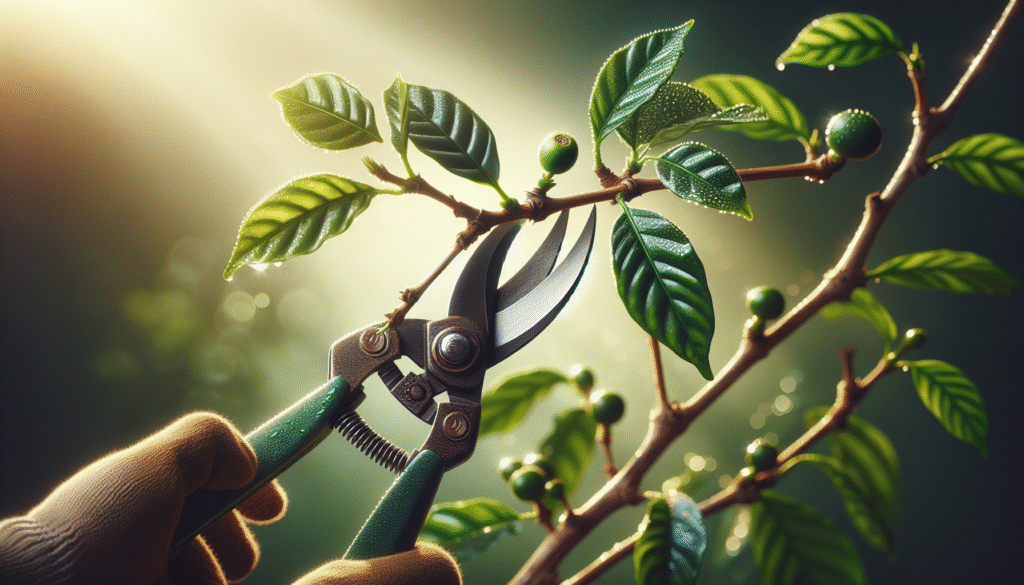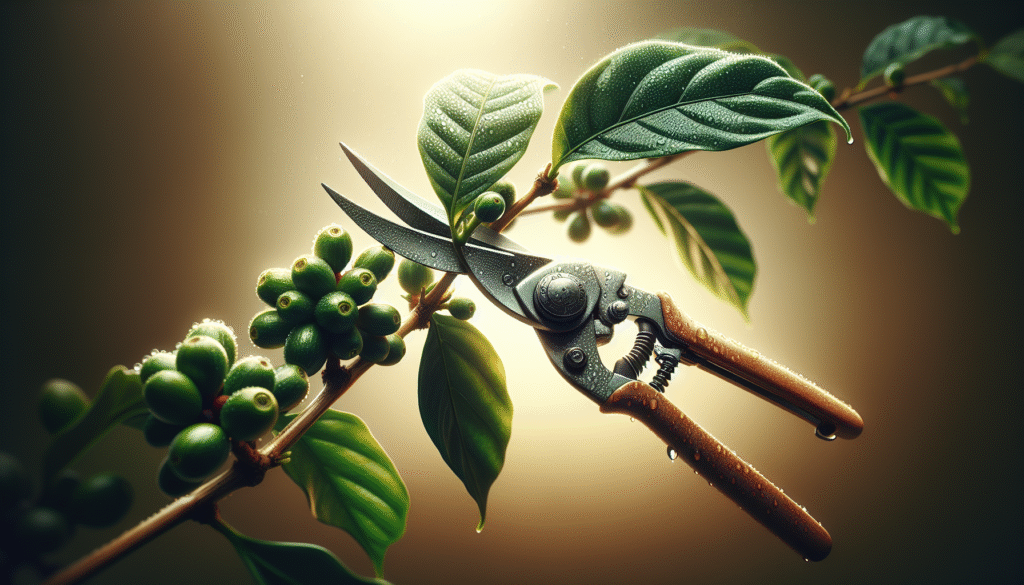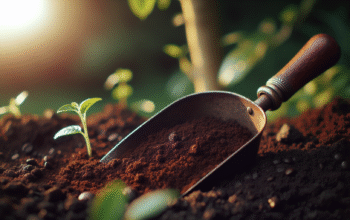Have you ever wondered how a few well-placed cuts could make your coffee plants healthier, more productive, and easier to manage?

Essential Guide to Pruning Coffee Plants for Healthy Growth
This guide shows you how to prune coffee plants so they stay vigorous, produce well, and resist pests and disease. You’ll learn practical steps, timing, tools, and troubleshooting so pruning becomes a predictable, rewarding part of your coffee care routine.
Why prune coffee plants?
Pruning keeps your coffee plants balanced, accessible, and productive. By removing old or crowded wood, you improve light penetration, air circulation, and the plant’s ability to direct resources to fruiting wood.
Pruning also helps control plant size, encouraging manageable heights for harvesting and reducing the risk of branches breaking under the weight of coffee cherries. When you prune correctly, you support long-term yield and plant health.
Pruning goals and principles
Every pruning cut should serve a clear purpose: shape, renew, reduce height, or remove dead or diseased wood. You should prune with the plant’s long-term architecture and your management needs in mind.
Think of pruning as guided growth rather than just cutting back. Your goal is to create a structure that maximizes light, prevents disease, and makes harvesting easier.
When to prune coffee plants
Timing depends on climate, variety, and production goals. Generally, you should prune after harvesting and before the main growth flush so new shoots have the entire wet season or growing period to develop.
If you live in a seasonal climate with a distinct dry season, prune at the beginning of the rainy season. In year-round wet equatorial regions, prune right after the major harvest period or during a natural low in flowering activity.
Seasonal considerations by region
Here’s a basic guide to timing by common coffee-growing climates. Use this as a starting point and adapt to your local cycles.
| Climate / Region | Best Timing | Why |
|---|---|---|
| Tropical highland (Arabica, wet-dry seasons) | After main harvest, before rainy season | New shoots grow during rains; reduces stress |
| Equatorial, year-round rain (some Robusta zones) | Shortly after main harvest or low flowering | Avoid cutting active fruiting wood |
| Subtropical or seasonal frost-risk areas | Late spring (after frost risk) | Avoid cold damage to fresh cuts |
| Dry-tropical zones with irrigation | Start of irrigation season | Ensures regrowth when water is available |
Types of pruning and when to use them
Different pruning approaches suit different ages and problems. Choose the method that matches your objective: training young plants, maintaining production, or renewing old, unproductive trees.
| Pruning Type | Use When | Effect |
|---|---|---|
| Formative (training) | Young plants (first 1–3 years) | Sets scaffold structure, height, and stem count |
| Maintenance (light pruning) | Mature, productive plants | Removes weak wood, shapes canopy, maintains size |
| Rejuvenation / Coppicing | Old, low-yield plants | Stimulates new vigorous growth from stumps |
| Stooling / Pollarding | For intense height control or re-sprouting | Encourages dense basal shoots for renewal |
| Tipping (sucker pruning) | To manage vegetative growth | Redirects energy to flowering branches |
Tools you need and sanitation
Good tools and clean practices make pruning safer and reduce disease spread. Keep your tools sharp and disinfected between plants.
| Tool | Purpose | Maintenance |
|---|---|---|
| Hand pruners (secateurs) | Snipping small shoots and twigs | Keep sharp; oil pivot; disinfect blades |
| Loppers | Cutting thicker branches up to ~2–3 cm | Sharpen blades; check bolt tension |
| Hand saw / pruning saw | Removing large branches | Clean resin and sap; keep teeth sharp |
| Pole pruner | Reach high branches | Inspect joints; replace worn rope/cord |
| Gloves & safety glasses | Protect hands and eyes | Replace if torn or contaminated |
| Disinfectant (70% alcohol, bleach solution) | Sanitizing tools | Rinse after bleach; avoid plant damage |
Sanitize blades with alcohol or a diluted bleach solution (1 part bleach to 9 parts water) between plants, especially when disease is suspected. Rinse and dry tools after bleach to prevent rust. You should disinfect again if you move from a diseased plant to healthy ones.
Formative pruning: training young coffee plants
Formative pruning builds a strong, productive framework and makes future maintenance easier. You should start shaping plants during their first 1–3 years.
Start by selecting a clear central leader for single-stem systems, or choose multiple leaders for multi-stem or stool-trained systems. Removing lower branches early helps establish scaffold spacing and reduces early light competition.
Steps for training seedlings and saplings
- After transplanting, cut the main stem back to 30–50 cm (12–20 inches) to stimulate branching.
- Allow 3–4 primary branches to develop if you plan a multi-stem structure, spacing them vertically.
- Remove branches that rub or grow inward toward the trunk; maintain outward-facing scaffolds.
- Keep a single central leader if your goal is a single trunk plant; prune lateral shoots that compete.
- Train branch angles to about 45–60 degrees using temporary ties if necessary to strengthen attachment.
By the end of the first year, you should have a neat structure that directs energy into a few well-spaced scaffold limbs.
Maintenance pruning for mature plants
Maintenance pruning removes dead, diseased, or crossing branches and opens the canopy to light and air. For already productive plants, you’ll focus on selective removal and height control rather than drastic cutting.
Prune lightly every year or every two years, depending on growth vigor. Always prioritize removing wood that shades inner canopy or impedes harvest.
Routine maintenance steps
- Remove dead wood and diseased branches first.
- Thin out overcrowded branches to improve airflow and light penetration.
- Cut back vertical water shoots that offer little fruiting value.
- Shorten long, weak branches to a lateral bud to encourage new fruiting wood.
- Keep canopy height at a manageable level for your harvest method.
Consistent maintenance avoids the need for severe rejuvenation later.
Rejuvenation pruning (coppicing and stooling)
When coffee plants become old, leggy, or low-yielding, rejuvenation can restore vigor. Coppicing (cutting the main stem near ground level) and stooling (cutting to a low stump to encourage basal shoots) are common methods.
These methods sacrifice one season of production to gain many years of vigorous regrowth. You should coppice when plants show a clear decline despite good care.
How to coppice or stool properly
- Choose a post-harvest period before the wet season so shoots can regrow.
- Remove the plant to a stump 10–30 cm above ground, depending on your stooling method.
- Leave a few buds on the stump or allow multiple new shoots to emerge.
- Select 1–4 vigorous shoots after they reach ~30 cm and remove the rest to focus resources.
- Manage these new shoots with formative pruning to rebuild a productive scaffold.
Expect reduced yield for the first 1–2 years, then a stronger, more productive plant in subsequent years.
Managing suckers, water sprouts, and epicormic shoots
Suckers from the base and water sprouts from trunks can sap energy and clutter the canopy. You should remove these regularly to preserve productive wood and focus the plant’s resources.
Suckers that replace lost leaders or serve as planned new stems can be useful, but random suckers should be removed at their base. Cut water sprouts flush with the branch they arise from, or remove larger ones at the collar with a clean cut.
Pruning to improve flowering, fruit set, and quality
Strategic pruning influences flowering and fruiting. Light pruning can stimulate a flush of new shoots that will bear flowers, while heavy pruning encourages vegetative growth first.
If you want to encourage uniform flowering, prune a few weeks to months before the expected flowering season. This will synchronize new vegetative growth so flowering happens more uniformly.
What to aim for in yield-oriented pruning
- Remove very old, non-productive wood to redirect energy.
- Thin the canopy to promote even light distribution and more uniform cherry ripening.
- Avoid heavy pruning close to flowering—this can reduce that season’s yield sharply.
With careful timing and selective cuts, you can influence both quantity and coffee quality.
Pruning for height control and harvest efficiency
Controlling height makes harvesting easier and reduces branch breakage. You can maintain your plants at a height you can reach with ladders or by hand.
Top-prune to a consistent height each cycle and shorten tall leaders to a lateral bud. If you use mechanical harvesters, shape rows for access and even canopy height.
Aftercare: nutrition, water, and wound handling
After pruning, the plant needs support to regrow and resist infection. Give pruned plants balanced nutrition, consistent moisture, and protection from extreme sun if freshly exposed.
- Apply a balanced fertilizer timed to the regrowth flush.
- Use mulch to conserve moisture and moderate soil temperature.
- Monitor for opportunistic pests and fungal infections at cut sites.
- Consider applying a wound dressing only if sap flow is excessive or the environment is very disease-prone—most healthy plants heal best without heavy dressings.
Avoid heavy nitrogen applications immediately after a major coppicing; encourage balanced recovery with N-P-K and micronutrients.
Dealing with pests and diseases in relation to pruning
Pruning can reduce disease by improving airflow, but if done poorly it can spread pathogens. Always disinfect tools between plants, and remove infected wood from the field immediately.
Common issues like coffee leaf rust or berry borer can be influenced by canopy density and hygiene. Thinning and removing infected branches lowers spore loads and insect harboring sites.
Cleaning and disposal recommendations
- Burn or deeply bury infected wood or remove it from the property when possible.
- Do not leave infected branches near healthy plants where spores or pests can transfer.
- Maintain an integrated pest management (IPM) strategy alongside pruning.

Propagation from pruning material
You can propagate coffee from cuttings if you want to expand your plantation or replace plants. Choose healthy, semi-hardwood cuttings and use rooting hormone for higher success rates.
- Select 10–15 cm cuttings with a couple of nodes.
- Remove the lower leaves and plant in a moist rooting medium under shade.
- Keep humidity high and avoid waterlogging.
Alternatively, stooling can produce basal shoots that are easily transplanted as new plants.
Common mistakes and how to avoid them
Many pruning problems start with poor timing, dirty tools, or overzealous cutting. Avoid removing too much of the canopy in one year, and don’t ignore sanitation.
| Mistake | Why it’s a problem | How you fix it |
|---|---|---|
| Cutting during active flowering | Reduces immediate yield | Schedule cuts after harvest or before growth flush |
| Using dirty tools | Spreads disease | Disinfect between plants and after diseased cuts |
| Removing too much canopy at once | Causes stress and weak regrowth | Stagger heavy cuts over seasons or select major shoots carefully |
| Leaving stubs | Encourages rot and disease | Cut cleanly at the branch collar |
| Not providing aftercare | New shoots fail or disease takes hold | Water, mulch, and apply balanced fertilizer |
Pruning schedule examples
Below is a general pruning calendar for a typical tropical highland Arabica system. Adapt timings to local climates, harvest timing, and varietal behavior.
| Period | Activities |
|---|---|
| Post-harvest (main) | Conduct main maintenance pruning; remove senescent wood |
| Dry season start | Avoid major cuts if severe drought expected; do light sanitation |
| Beginning of rainy season | Perform formative and rejuvenation cuts to take advantage of rains |
| Mid-growth flush | Thin canopy lightly; remove competing leaders and suckers |
| Pre-harvest | Minimal pruning; focus on pest/disease checks and minor shaping |
Pruning checklist you can use in the field
Use this simple checklist during pruning rounds so you don’t miss critical tasks.
- Sanitize tools before starting
- Remove dead and diseased branches first
- Thin crowded areas to improve light and airflow
- Shorten overly long branches to a healthy lateral
- Remove suckers at the base or as planned
- Tag coppiced plants for follow-up management
- Mulch and water pruned plants as needed
- Record major cuts and note plants needing special care
Safety and ergonomics while pruning
Pruning can be physical work—protect your back, hands, and eyes. Use proper posture, take breaks, and use ladders or pole pruners safely.
Wear gloves, safety glasses, and sturdy footwear. Inspect ladders and poles before use, and never overreach. If cutting larger branches, work from stable positions and have a helper where possible.
Special notes for different varieties: Arabica vs Robusta
Arabica typically benefits from more selective, light pruning and careful timing relative to flowering. Robusta often tolerates heavier pruning and coppicing and is usually grown in denser stands.
Your pruning style will vary with cultivar vigor, susceptibility to wind or disease, and the intended production system (shade-grown vs full sun).
Practical examples: scenarios and solutions
- Problem: Your plants are tall and hard to harvest.
- Solution: Reduce leaders to a manageable height over 2 seasons; maintain lateral scaffolds for bearing wood.
- Problem: Yield declines with many dead branches near the center.
- Solution: Thin canopy to restore light; remove dead wood; consider selective coppicing if widespread decline.
- Problem: Disease spreading across rows after pruning.
- Solution: Stop pruning, disinfect tools, remove and destroy infected material, and re-evaluate timing.
Each situation requires observation and a tailored plan; use these examples as starting points.
Frequently asked questions (FAQ)
Q: How much should you cut off in a single pruning session? A: Aim to remove no more than 20–30% of the canopy for mature plants in a single session, unless you’re rejuvenating. For young plants, formative cuts can be more radical but focused.
Q: Can coffee plants recover from drastic coppicing? A: Yes, coffee plants typically recover well from coppicing with proper timing and care, though yields are reduced during the recovery year.
Q: Should you apply wound paint to pruning cuts? A: Most healthy coffee plants heal well naturally. Use wound paint only in very disease-prone environments or if sap loss is excessive.
Q: How often should you perform maintenance pruning? A: Annually for most productive systems, or biannually if growth is particularly vigorous and you need more frequent management.
Troubleshooting poor regrowth
If regrowth after pruning is weak, check soil fertility, moisture, and root health. Pest damage, poor root space, or insufficient nutrients are common causes. Provide balanced fertilizer, adequate water, and address pests promptly.
If regrowth is overly vegetative (too leafy, few flowers), slightly reduce nitrogen and ensure adequate potassium and phosphorus to support flowering.
Final tips for successful pruning
- Plan your pruning with the plant’s growth cycle in mind.
- Keep one or two clear objectives for each pruning session.
- Maintain good tool care and sanitation.
- Follow up pruning with proper water, mulch, and nutrition.
- Record what you do so you can refine timing and methods over years.
Pruning well is a low-cost, high-impact practice that pays off in healthier plants, better harvests, and easier management. With regular observation and small adjustments, you’ll quickly find a pruning rhythm that fits your farm or garden.
Summary and next steps
Now that you understand timing, methods, tools, and aftercare, you can create a simple, repeatable pruning plan. Start by evaluating a few plants, making conservative cuts, and observing the response over the next growth cycle.
If you want, pick one block or row to trial a new method—formative, maintenance, or coppicing—and keep notes on yield and vigor. Over a couple seasons you’ll find what works best for your varieties and climate, and pruning will become one of the most rewarding parts of your coffee cultivation routine.



